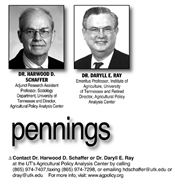Food Assistance Programs Feed The Hungry But Also Boost Rural And Urban Economies

In our agricultural policy classes and presentations to food and agricultural groups we talk about the price/income problem that farmers face in most years and various types of government programs that have the potential to stabilize farm income at a sustainable level. One of those is is described as demand enhancement programs.
The idea is that if the government increases the demand for agricultural products through something like the Supplemental Nutrition Assistance Program (SNAP, previously known as food stamps), that extra demand will result in higher prices for the affected agricultural products.
If the ability to increase the total food supply were relatively inelastic, such programs would be an easy way to increase the price of agricultural products with minimal governmental involvement in farm production decisions. Unfortunately, from a price perspective, farmers have repeatedly shown that they have the ability to increase the supply of agricultural products faster than the increase in demand generated by these programs.
The increased demand gets baked into farm production decisions. As a result, farmers face extended periods of prices that are below the full cost of production punctuated by short periods of higher prices brought about by weather events like droughts or governmental decisions like wars (WWI and WWII) or the entry of the Soviet Union into the world grain markets in the early 1970s.
While concept of demand enhancement may have provided some of the initial support for SNAP’s prececessor programs, today the rationale for these programs has shifted to humanitarian concerns and the concept of the right to food, though farm groups would be loathe to give up the demand for their products generated by SNAP and other food assistance programs like school nutrition programs.
With this background in mind, we want to turn to a recent report published by the Economic Research Service (ERS) of the United States Department of Agriculture (USDA) titled “Impact of USDA’s Supplemental Nutrition Assistance Program (SNAP) on Rural and Urban Economies in the Aftermath of the Great Recession,” and written by Stephen Vogel, Cristina Miller, and Katherine Ralston (https://tinyurl.com/zacc8spt ).
The report’s examination of the impact of the SNAP program focuses not on the years of the subprime mortgage crisis (2007-2008), but on the 2009-2014 period of slow recovery and the impact of increased “SNAP benefit outlays on employment, output, and household incomes for the rural economy compared to the to the urban economy.”
Following the subprime mortgage crisis, full-time employment did not reach the 2007 level until 2014 while real GDP (gross domestic product) reached the 2007 level in 2010. “Throughout the Great Recession’s aftermath, average real wages stagnated or declined, while high levels of involuntary part-time employment persisted through 2017.”
The report classifies urban counties as “central counties with one or more areas of urban entities of 50,000 or more people, and their outlying counties are economically linked via specified labor-force commuting patterns. ‘Rural’ counties lie outside the boundaries of these metropolitan areas.” Because the analysis was conducted at the county level, the urban category in the report includes significant agricultural areas in counties surrounding central cities. The economy of rural areas, as described in the report, is about “one-seventh the size of the urban economy.
The county-level maps in the publication show that much of the slow recovery from the Great Recession in rural areas was concentrated not in the Northern and Central Plains States, but rather in low- agricultural-production areas like Appalachia.
SNAP (a federal program composed of slightly different programs in each of the 50 states) “the largest domestic anti-hunger programs in the United States, provides nutrition assistance payments to low- income Americans for food purchases.” But, in that role its impact on the national economy extends beyond that, serving “as an automatic stabilizer by increasing program outlays during economic downturns, as more households become eligible for program benefits due to unemployment, involuntary underemployment, or loss of business income.”
The ERS study found that the annual average of $71 billion in SNAP benefits spent during the 2009-2014 period resulted in $198.2 billion in economic benefits for the US. The impact on the rural economy was $48.8 billion or 1.25 percent while the urban numbers are 149.3 billion or 0.53 percent. The impact of SNAP benefit outlays on employment was similar supporting 279,000 additional jobs (1.18 percent) in rural areas, and 811,000 additional jobs (0.50 percent) in urban areas.
In addition to their central objective of feeding the hungry, humanitarian food programs, like SNAP, also provide an important boost to rural and urban economies, particularly during economic crises. ∆
DR. HARWOOD D. SCHAFFER: Adjunct Research Assistant Professor, Sociology Department, University of Tennessee and Director, Agricultural Policy Analysis Center
DR. DARYLL E. RAY: Emeritus Professor, Institute of Agriculture, University of Tennessee and Retired Director, Agricultural Policy Analysis Center